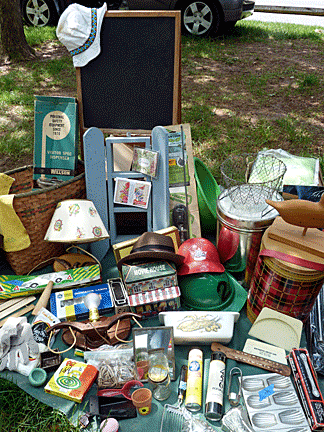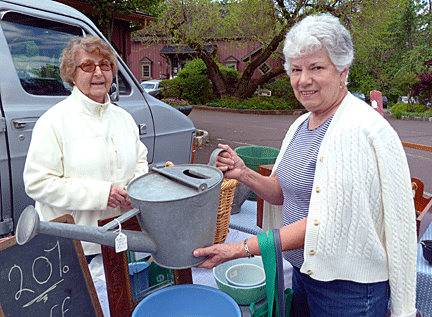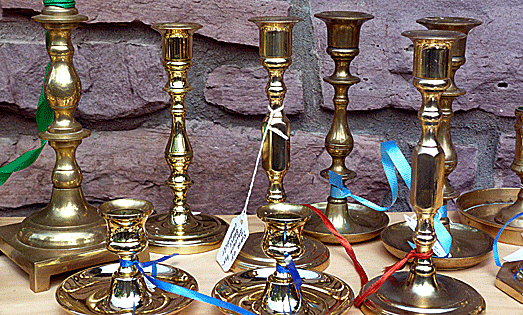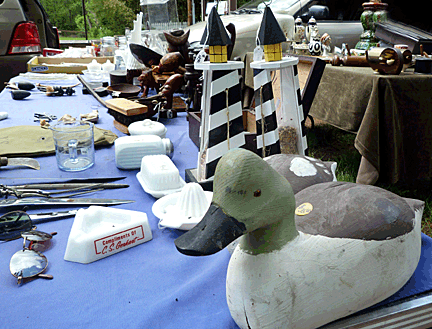|
How Much is This?
by Bob Brooke
 “How
much is this?” If you have to ask, then the antique shop or flea market
dealer hasn’t completed their job—or the person is just downright lazy. “How
much is this?” If you have to ask, then the antique shop or flea market
dealer hasn’t completed their job—or the person is just downright lazy.
I went to a favorite flea market of mine last Saturday. I say favorite
only because it’s the only regular one left in my area—it occurs on the
third Saturday of each month from mid-Spring to late Fall. A lot of the
same dealers display some of the same things they’ve had for sale for
the last couple of years.
While most of the dealers price their goods beforehand, a few don’t.
Take Mr. I-Don’t-Price-Anything, Mr. Idpa for short. This rather smug
dealer always seems to offer interesting items, none of which has a
price. So I’m always forced to ask, “How much is this?”
There’s a slight pause as Mr. Idpa sizes me up. If he thinks I’m a
Yuppie with a Beamer parked out under the trees, he’ll immediately raise
his price by as much as 50 percent, even before he says anything. I know
this because I’ve conducted a little study over the last few months in
which I wear different styles of clothes on different visits to the
market. I then pick the same or similar item and ask the same question:
“How much is this?” He rarely remembers me and so far, none of the
prices quoted for the same item have been the same.
 A
few times I really wanted an item I collect, but resisted because not
only did he make up prices as he went along, he also refused to bargain
when I asked “What’s your best price?’ If he were the only dealer doing
this, I would just pass by his space. But, unfortunately, he’s
not–although he’s the king. A
few times I really wanted an item I collect, but resisted because not
only did he make up prices as he went along, he also refused to bargain
when I asked “What’s your best price?’ If he were the only dealer doing
this, I would just pass by his space. But, unfortunately, he’s
not–although he’s the king.
Last week, a new dealer had set up next to Mr. Idpa and like him, she
hadn’t priced her goods. As I neared her table, I overheard her say to
another woman, “I don’t understand why no one has asked about my
chairs.” She had four well-used ladderback rushed chairs arranged out in
front of her tables, each nicely draped with colorful silk scarves.

After the woman left, I approached her and said, “Perhaps it’s because
you don’t have any prices on your items.”
“Do you think that’s it?” she asked.
I explained that customers need a place to start—a pricing reference
point. “When I approach a dealer’s tables and see something I like, I
look at the item, then at its price to see if it’s within my budget.
 “But
I thought prices might scare customers away,” she replied. “But
I thought prices might scare customers away,” she replied.
“Not at all,” I said. “ You see, people who are serious collectors, like
me, come here [to flea markets] looking for items to add to our
collections...for the right price, of course. If a dealer overprices an
item, I move on. But if it’s within my price range, I begin a
conversation with the dealer about it.”
Just then, a woman approached the dealer carrying an old hand washboard
she had picked up out near the dealer’s chairs. The washboard had a
price on it of $18. From my previous conversation with the dealers, I
assumed she left the previous price sticker on from when she bought it.
I stepped aside and let them haggle. A few minutes later, the customer
walked away with the washboard under her arm and a smile on her face.
I again approached the dealer and said, “That makes my point.”
“I guess so, “ she replied. “Now what can I use for price stickers.”
<
Back to Antiques Extra! Archives
Next Editorial
> |
